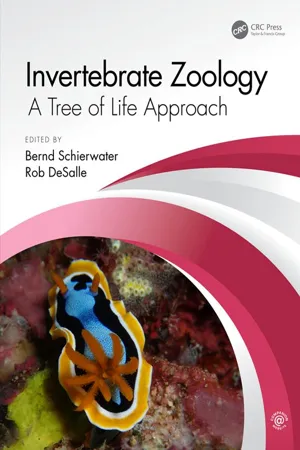
- 630 pages
- English
- ePUB (mobile friendly)
- Available on iOS & Android
About this book
Invertebrate Zoology: A Tree of Life Approach is a comprehensive and authoritative textbook adopting an explicitly phylogenetic organization. Most of the classical anatomical and morphological work has not been changed – it established the foundation of Invertebrate Zoology. With the explosion of Next-Generation Sequencing approaches, there has been a sea-change in the recognized phylogenetic relationships among and between invertebrate lineages. In addition, the merger of evolutionary and developmental biology (evo-devo) has dramatically contributed to changes in the understanding of invertebrate biology. Synthesizing these three approaches (classical morphology, sequencing data, and evo-devo studies) offers students an entirely unique perspective of invertebrate diversity.
Key Features
- One of the first textbooks to combine classical morphological approaches and newer evo-devo and Next-Generation Sequencing approaches to address Invertebrate Zoology
- Organized along taxonomic lines in accord with the latest understanding of invertebrate phylogeny
- Will provide background in basic systematic analysis useful within any study of biodiversity
- A wealth of ancillary materials for students and teachers, including downloadable figures, lecture slides, web links, and phylogenetic data matrices
Frequently asked questions
- Essential is ideal for learners and professionals who enjoy exploring a wide range of subjects. Access the Essential Library with 800,000+ trusted titles and best-sellers across business, personal growth, and the humanities. Includes unlimited reading time and Standard Read Aloud voice.
- Complete: Perfect for advanced learners and researchers needing full, unrestricted access. Unlock 1.4M+ books across hundreds of subjects, including academic and specialized titles. The Complete Plan also includes advanced features like Premium Read Aloud and Research Assistant.
Please note we cannot support devices running on iOS 13 and Android 7 or earlier. Learn more about using the app.
Information
INVERTEBRATES AND INFORMATIONCHAPTER
1

FINDING INFORMATION ABOUT INVERTEBRATE TAXA
| Placozoa1 | https://www.cell.com/current-biology/fulltext/S0960-9822(17)31524-5 |
| Porifer2 | https://www.cell.com/current-biology/fulltext/S0960-9822(05)00143-0 |
| Cnidaria3 | https://www.cell.com/current-biology/fulltext/S09609822(13)00359-X |
| Cnidaria (Hydrozoa)4 | https://www.cell.com/current-biology/fulltext/S0960-9822(10)01172-3 |
| Ctenophora5 | https://www.cell.com/current-biology/fulltext/S0960-9822(08)01291-8 |
| Ctenophora5A | https://www.sciencedirect.com/science/article/pii/S0960982216309800 |
| Mollusca6 | https://www.cell.com/current-biology/fulltext/S0960-9822(12)00592-1 |
| Platyhelminthes7 | https://www.cell.com/current-biology/comments/S0960-9822(17)30152-5 |
| Bryozoa8 | https://www.cell.com/current-biology/fulltext/S0960-9822(14)00533-8 |
| Chaetognatha9 | https://www.cell.com/current-biology/fulltext/S0960-9822(06)01835-5 |
| Gnathifera10 | https://www.cell.com/current-biology/fulltext/S0960-9822(18)31541-0 |
| Crustacea11 | https://www.cell.com/current-biology/fulltext/S0960-9822(08)00658-1 |
| Insecta12 | https://www.cell.com/current-biology/fulltext/S0960-9822(15)00927-6 |
| Chelicerata13 | https://www.cell.com/current-biology/fulltext/S0960-9822(18)30672-9 |
| Arthropods14 | https://www.cell.com/current-biology/fulltext/S0960-9822(19)30486-5 |
| Onychophora15 | https://www.cell.com/current-biology/pdf/S0960-9822(11)00208-9.pdf |
| Tardigrada16 | https://www.cell.com/current-biology/fulltext/S0960-9822(16)30007-0 |
| Nematoda17 | https://www.cell.com/current-biology/fulltext/S0960-9822(13)00985-8 |
| Echinodermata18 | https://www.cell.com/current-biology/fulltext/S0960-9822(05)01401-6 |
| Xenoturbellida19 | https://www.cell.com/current-biology/comments/S0960-9822(16)30191-9 |
| Enteropneusta20 | https://www.cell.com/current-biology/fulltext/S0960-9822(02)00491-8 |
| Tunicata21 | https://www.cell.com/current-biology/fulltext/S0960-9822(15)01521-3 |
| Chordates22 | https://www.cell.com/current-biology/fulltext/S0960-9822(05)01326-6 |
| Choanoflagellata23 | https://www.cell.com/current-biology/fulltext/S0960-9822(05)00142-9 |
Table of contents
- Cover
- Half Title
- Title Page
- Copyright Page
- Dedication
- Contents
- PREFACE
- ACKNOWLEDGEMENTS
- EDITORS
- CONTRIBUTORS
- PROLOGUE: INTRODUCTION: SETTING THE STAGE FOR A RATIONAL TREATMENT OF INVERTEBRATE ANIMALS
- CHAPTER 1 INVERTEBRATES AND INFORMATION
- CHAPTER 2 THE BASICS OF PHYLOGENETICS
- CHAPTER 3 INVERTEBRATE PHYLOGENOMICS
- CHAPTER 4 MODERN INVERTEBRATE SYSTEMATICS
- CHAPTER 5 ORGANIZING INVERTEBRATES
- HIGHER TAXA 1: INTRODUCTION TO THE INVERTEBRATE TREE OF LIFE
- HIGHER TAXON 2: CNIDARIA
- HIGHER TAXON 3: BILATERIA
- HIGHER TAXON 4: LOPHOTROCHOZOA
- HIGHER TAXA 5: ECDYSOZOA AND ARTHROPODA
- HIGHER TAXON 6: DEUTEROSTOMIA